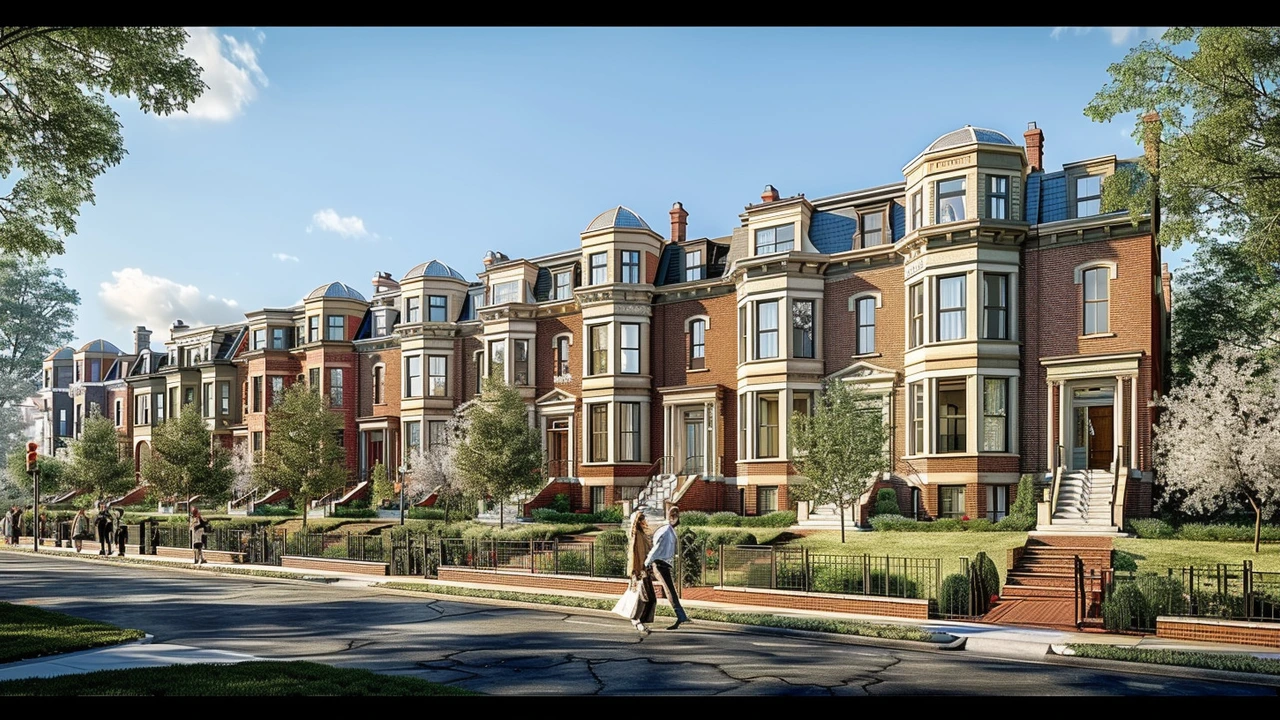Federal Architecture: Elegance and Symmetry Embodied
 Jun, 22 2024
Jun, 22 2024
Emerging in the United States during the late 18th and early 19th centuries, Federal architecture encapsulates a period of elegance and refined tastes. It draws inspiration from classical Roman and Greek forms, implementing these ideas into the new nation's ethos.
Characterized by its symmetry, clean lines, and understated decorative details, Federal architecture gained popularity as the budding nation sought to express its aspirations through building design. Not only does this style reflect a young society's fascination with the classical ideals of beauty and harmony, but it also serves as a physical testament to the country's historical journey.
In exploring this architectural form, one can discover its roots, defining features, and exemplary structures scattered across cities and towns. This journey provides a deeper understanding of the style's cultural resonance and offers practical insights on how to identify and appreciate the quiet grandeur of Federal architecture.
- Origins of Federal Architecture
- Key Characteristics of Federal Architecture
- Notable Examples of Federal Architecture
- Cultural and Historical Significance
- Tips for Recognizing Federal Architecture
Origins of Federal Architecture
Federal architecture sprouted in the United States during the late 18th century, a time marked by significant political and cultural transformation. The period following the American Revolution was ripe for a new architectural style that symbolized the fledgling nation's aspirations and identity. This style found its roots in the classical traditions of Roman and Greek design, inspired by the architectural forms that influenced Thomas Jefferson and other American leaders.
In Britain, the style was known as Georgian, named after the monarchs of the time. But as America sought to delineate its own identity, it adapted these elements into what became known as Federal architecture. These early American architects looked to the symmetry, proportion, and balance of classical buildings, incorporating these ideals into their work. The influence of European architects such as Andrea Palladio was also evident, highlighting a blend of old-world charm with new-world innovation.
The name 'Federal' itself reflects the new nation's federal system of government, emphasizing unity and strength. Prominent figures like Benjamin Latrobe and Charles Bulfinch played essential roles in popularizing this style. Latrobe, often considered the father of American architecture, incorporated Federal style elements into public buildings, embedding it deeply into the country’s architectural fabric.
According to an article in The Architect’s Journal, “Federal architecture stands as an enduring symbol of the United States’ formative years, marrying practicality with an aesthetic rooted in classic refinement.”
During this period, the construction of landmarks such as the Massachusetts State House and the original U.S. Capitol building commenced, showcasing the style's defining characteristics. These buildings typically featured flat or low-pitched roofs, large window sashes, and minimal ornamentation, emphasizing light and spacious interiors. This simplicity and elegance resonated with the ideals of the Enlightenment, which valued reason, clarity, and order.
The Federal style also found its way into residential design. Homes built during this era often had symmetrical facades, elliptical fanlights above doors, and decorative moldings. The concept of the individual home as a private sanctuary emerged in this period, reflecting the newly established American ideals of freedom and personal space.
In essence, Federal architecture embodies a unique blend of cultural influences, national identity, and classical beauty. Its origins provide a window into the values and aspirations of early American society, heavily influenced by the need to establish a distinct and unified identity.
Key Characteristics of Federal Architecture
Federal architecture stands out with its emphasis on symmetry and balanced proportions. This style often features a central doorway adorned with a semicircular fanlight, a decorative element that allows natural light to filter into the entryway while enhancing the façade's elegance. The doorway is typically flanked by sidelights and, occasionally, pilasters or columns that underscore the classical inspiration of the design.
The geometric simplicity is another hallmark of Federal architecture. Walls are usually smooth and feature subtle decorative details rather than elaborate ornamentation. Windows, arranged symmetrically across the façade, often have thin muntins dividing them into smaller panes, reinforcing the delicate, refined aesthetic. Paired or triple windows in prominent positions can sometimes be seen, providing visual interest without detracting from the overall symmetry.
Distinctive Elements
One cannot discuss Federal architecture without highlighting the use of Palladian windows. These large, triple-sectioned windows feature a central arched section flanked by two smaller, square-topped windows. Inspired by the neoclassical designs of Renaissance architect Andrea Palladio, these elements lend an air of grandeur and light to the buildings. Equally noteworthy are the decorative moldings that trace the rooflines and frame building edges.
Rooflines in Federal architecture are typically low-pitched or flat, often concealed behind a balustrade or parapet. This design choice harks back to classical influences and contrasts sharply with the steeper rooflines of earlier colonial architecture. Cornices also play a significant role in the style, often featuring dentil moldings—a series of small, squared projections resembling teeth.
"The Federal Style is characterized by a feeling of lightness and delicacy, achieved through its graceful proportions and restrained use of architectural ornament." - Historic New England
Materials used in Federal architecture contribute to its distinctive look. Brick is a common choice, usually laid in Flemish bond, where alternating headers and stretchers create a visually appealing and structurally sound pattern. Wooden clapboards are also prevalent, particularly in areas where brick was less accessible. Paint colors tend to be muted and classical—creams, whites, soft grays, and delicate blues, all aligning with the restrained elegance of the period.
Indoor Features and Decorations
Inside, Federal homes continue the theme of symmetry and balance. Rooms are often arranged around a central hallway, with grand, sweeping staircases as a focal point. Decorative elements such as plasterwork ceilings, intricate woodwork, and marble fireplace mantels are common. These details reflect the craftsmanship and attention to detail that defines the Federal style. Walls may be adorned with painted murals or wallpaper featuring neoclassical motifs—urns, festoons, and swags.
In sum, identifying Federal architecture involves looking for a harmonious combination of symmetry, classical details, and restrained elegance. Whether observing a building's exterior or interior, these key characteristics seamlessly blend to create a style that is both historically significant and aesthetically timeless.

Notable Examples of Federal Architecture
Federal architecture has left an indelible mark across the United States, with numerous iconic buildings exemplifying this elegant style. One of the most famous examples is the Massachusetts State House in Boston. Designed by Charles Bulfinch, a pivotal figure in American architecture, this structure is easily identifiable by its grandiose gold dome and stately facade, which capture the symmetry and modest ornamentation characteristic of the Federal style.
Another remarkable example is the Octagon House in Washington, D.C. Built in the early 19th century by Col. John Tayloe III, this house is renowned for its unique shape and historical significance. It served as a temporary residence for President James Madison after the White House was burned during the War of 1812. The Octagon's balanced design and refined decorations stand as a testament to the Federal style’s graceful simplicity.
In the realm of residential architecture, the Nathaniel Russell House in Charleston, South Carolina, is a standout. Constructed in 1808, it is celebrated for its “free-flying” staircase, a marvel of engineering and aesthetic elegance. The house's exterior displays the symmetry and balanced proportions typical of Federal architecture, while the interior showcases intricate plasterwork and delicate details. The Nathaniel Russell House offers a glimpse into the lifestyle and tastes of the period's affluent citizens.
Also noteworthy is the Telfair Academy in Savannah, Georgia. Originally built as a private residence in the early 19th century, it was later converted into one of the first public art museums in the United States. The building’s Federal-style elements are evident in its neoclassical design and harmonious proportions, making it a key cultural landmark. The Telfair Academy not only embodies the artistic and architectural principles of its time but also connects Savannah's rich historical tapestry to the broader narrative of American Federal design.
Adding to the array of iconic Federal structures is the United States Capitol Building in Washington, D.C. Although it has undergone numerous expansions and renovations, its original design by William Thornton adheres to Federal architectural principles. The Capitol's dome and its expansive, orderly wings reflect the style's emphasis on grandeur combined with simplicity. This building remains a powerful symbol of American democracy and architectural excellence.
From public buildings to private residences, Federal architecture's influence is widespread and profound. Its emphasis on symmetry, proportion, and restrained ornamentation can be seen throughout the United States, reflecting a shared appreciation for classical ideals adapted to a new and growing nation. By visiting these historic landmarks, one can truly appreciate the elegance and enduring appeal of Federal architecture.
Cultural and Historical Significance
Federal architecture is more than just a structural style; it’s a reflection of a nation's identity in its formative years. Emerging shortly after the American Revolution, this architectural approach embraced the aspirations and ideals of the young republic. By adopting elements from Roman and Greek architecture, the style communicated a link to the classical ideals of democracy and governance, symbolizing stability and enduring principles.
The buildings constructed in this style were a physical manifestation of the nation’s values and ambitions. Public buildings like the Massachusetts State House, designed by Charles Bulfinch, didn’t just serve bureaucratic functions; they stood as monuments to the republic’s vision. This style seamlessly blended functionality with aesthetic grace, where each element represented a considered decision to reflect the era's spirit.
Thomas Jefferson, a key figure in American history, was also a proponent of Federal architecture. He believed strongly in its capacity to inspire and reflect a burgeoning nation’s cultural ethos. His home, Monticello, though often classified as Palladian, also carries the essence of Federal design in its symmetry and elegance. Jefferson’s influence extended to public architecture, impacting structures like the Virginia State Capitol.
The preference for symmetry in Federal architecture was not merely an artistic choice but a philosophical one. Symmetry suggested balance and order, qualities that were highly valued during the nation’s infancy. Buildings from this period often feature evenly spaced windows, dormers, and other elements that create a harmonious look. The use of decorative moldings and fanlight windows added a touch of delicacy without overshadowing the overall clarity of the design.
Federal architecture also left its mark on residential designs. The Adam style, originating from the work of Scottish architects Robert and James Adam, introduced intricate interior designs that influenced American homes. Known for their elegant decorative motifs, these homes often featured oval-shaped rooms and elaborate plasterwork, emphasizing a refined domestic life that mirrored the public structures of governance and communal identity.
“To ensure that our Republic remains a shining example of freedom and democracy, its public buildings must reflect not just functionality, but the ideals we hold dear.” — Thomas Jefferson
As the nation expanded westward, the principles of Federal architecture traveled, adapting to new regions while maintaining its core characteristics. Even as new styles emerged and architectural tastes evolved, the influence of Federal design endured. It left a legacy in American architectural tradition, reinforcing the importance of symmetry, proportion, and understated elegance in building design.
In summary, the cultural and historical significance of Federal architecture extends beyond its aesthetic appeal. It encapsulated an era of idealism and experimentation, embedding the young nation's values into the very fabric of its structures. These buildings were more than mere shelters or workplaces; they were expressions of a shared identity and a hopeful vision for the future, setting a timeless precedent in the architectural chronicles of the United States.

Tips for Recognizing Federal Architecture
Recognizing Federal architecture can transform a casual stroll through historic districts into an immersive cultural experience. The first hallmark is symmetry, as these buildings are meticulously balanced. Look for a central entrance flanked by an equal number of windows on either side, often accompanied by decorative elements like fanlights or transoms above the door.
When you observe the exterior, check for a smooth, unbroken facade. Brick and wood are frequently used, with bricks being laid in a Flemish bond pattern. The use of materials like marble or stone for detailing around doors and windows is another clue. Most buildings feature restrained yet elegant decorations—dentil moldings along the roofline and simple, understated cornices are common features.
Another distinctive characteristic is the low-pitched or flat roofs, often concealed behind a decorative parapet. You might also notice classical elements like columns or pilasters near the entrance, a nod to the influences of Roman and Greek architecture. Windows are usually sash windows with smaller panes of glass, arranged symmetrically with six panels on each sash.
The interior of a Federal-style home is equally telling. Rooms are typically rectangular and proportionate, maintaining the sense of symmetry and balance of the exterior. The walls often have decorative woodwork like wainscoting and chair rails, while fireplaces feature elegant mantels with classical motifs, symbolizing both functionality and ornamental beauty.
Michael Kathrens, an architectural historian, once summed up the essence of Federal architecture beautifully:
"Federal architecture reveals its beauty subtly through symmetry, proportion, and restrained ornamentation. It reflects a young nation's ambition and respect for classical ideals."
Beyond visual cues, understanding the historical context aids in recognizing Federal architecture. This style flourished between 1780 and 1830, paralleling America's early years of independence. Many public buildings designed by prominent architects of the time, like Charles Bulfinch, embody the Federal style. Visiting examples like the Massachusetts State House or the United States Capitol can offer more direct insights into this architectural form.
Gaining familiarity with Federal architecture enriches one’s appreciation for historical buildings and the narratives they embody. Next time you find yourself in a historic district, take a moment to observe the symmetry, the understated elegance, and indeed, the story these buildings are eager to tell.